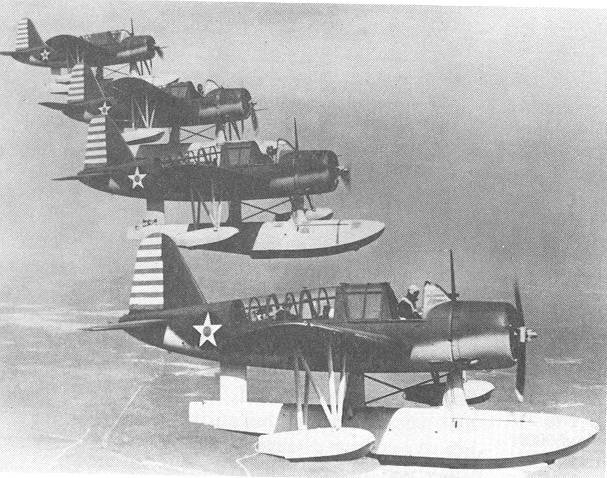

In 1937 the Navy issued a new specification for an "Observation-Scout" aircraft to operate from the fleet's battleships.
While a casual reader would deem this an overlap from the "Scout-Observation" Curtiss SOC floatplanes in already use in the late
1930s, the designation represented the subtle difference in-which floatplanes from the battleships and cruisers were actually operated.
The OS requirement was for a two seat floatplane with non-folding wings (a luxury allowed because the aircraft were not stored in
hangers on the battleships) and the fixtures for quick conversion to landplane.
Three companies offered designs to meet the new specification. The Naval Aircraft Factory XOSN-1, the Stearman XOSS-1,
and the Vought XOSU-1 (actually a modified O3U-6) were all biplane types with central floats. Seeing the mediocre potential
of the biplane, Vought designer Rex Biesel proposed a radical departure -- an all metal monoplane. Ordered in March 1937,
the new OS made its first flight on March 1, 1938. The XOS2U-1 featured full span flaps, spot welding, and spoiler lateral control.
However, to remain under the weight requirements imposed by shipboard handling, a small Pratt & Whitney R-985-4 engine
producing 450hp was chosen. The type could operate as a floatplane or land plane as required. Defensive armament was one
fixed 0.30 cal machine gun in the nose and one similar gun on a flexible mount for the observer. Offensive armament consisted
of two 116-lb bombs.
The type was placed into production with the R-985-48 engine, a radio DF loop, and some minor modifications to the floats.
Vought delivered 54 OS2U-1s by November 1940. They quickly gained a reputation for reliability, despite the modest performance
governed by the low powered engine.
The OS2U-2 model introduced leak-proof fuel tanks, armor protection, as well as the more powerful R-985-50 engine, delivering
the same 450hp but at 5000 feet! The new mark could also carry two 325lb depth charges. Beginning in November 1940, 158 of
this model was delivered. Although 45 were delivered as floatplanes, the remainder arrived as land planes, along with 70 extra sets
of floats. Most of the land plane types went to inshore patrol squadrons forming from September 1940 onward.
The OS2U-3 was similar to the OS2U-2, with modifications to facilitate mass production. In addition the OS2U-3 included
more fuel tankage and a better armor arrangement. The engine was renamed R-985-AN-2 or -8 depending on production batch.
From July 1941 to September 1942, Vought completed 1,006 of the floatplanes. In order to clear factories for the F4U fighters,
production passed to the Naval Aircraft Factory. The OS2N-1 was identical in most respects to the OS2U-3. Three hundred of
these were added to the Vought production totals. All told over 1,500 of all OS2U types were built.
At the time of Pearl Harbor, all the Navy's battleships were equipped with the OS2U. Additionally, the carriers Saratoga, Wasp,
and Hornet as well as the seaplane tenders Albemarle, Barnegat, Biscayne, Casco, Curtiss, Heron, Humbolt, Pocomoke, Tangier,
and Wright, used the type for utility work. However the majority of Kingfishers were assigned to either NAS Pensacola or NAS
Jacksonville. The latter location was the central post for the newly forming Inshore Patrol Squadrons. During the war five Fletcher
class destroyers were commissioned with catapults and equipped with OS2Us. When the SO3C type failed to replace the older
SOC biplanes on USN cruisers, some OS2Us found their way onto cruiser decks.
The Kingfishers saw action in all theaters. As spotting roles gave way to ship's radars, the battleship-based planes were used for
general utility, air-sea rescue, and anti-submarine patrol. Shore based squadrons operated mainly in the later role throughout the war.
However the type was called to perform bombing missions, target tug duties, as well as to chase down practice torpedoes.
The USN was not the only user of the Kingfisher. Fifty-three OS2U-3/OS2N-1s were allocated for the Coast Guard.
These were used for convoy escort and anti-submarine patrol. The Royal Navy received 100 as Kingfisher I. These served
on armed merchant cruisers, light cruisers, and as trainers. Australia and the Soviet Union also received lend-lease Kingfishers.
Others were exported to Mexico, Cuba, Uruguay, Chile, and the Dominican Republic.
With such wide service, the Kingfishers had some memorable missions. On July 15, 1942, two OS2Us helped sink the U-576.
Kingfishers based in the Aleutians dive bombed Japanese positions. Over Iwo Jima, one OS2U actually shot down a Japanese Zero fighter.
Another Kingfisher rescued Eddie Rickenbacker near Funafuti Island (the World War I ace had spent several weeks at sea after his B-17 crashed).
Lt JG Rollin M. Batten, Jr braved the shore guns of Guam Island to resecue two downed aviators, earning the Navy Cross.
But Lt John A. Burns holds the record for rescued aviators with ten in one day while operating near Truk.
SPECIFICATIONS
Wing Span: 35 feet 11inches (10.69 meters)
Length: 33 feet 7 inches (10.34 meters)
Height: 15 feet 0,5 inches (4.58 meters)
Wing Area: 262 square feet (24.3 square meters)
Empty Weight: 3,442 pounds (1561.26 kg)
Gross Weight: 4,926 pounds (2234.38 kg)
Maximum Speed: 175 mph (282 km/h)
Cruise Speed: 116 mph (186 km/h)
Service Ceiling: 19,000 feet (5,791meters)
Initial Climb Rate: 890 feet (271 meters) per minute
Range: 982 miles (1580 km)
Armament: 1 x .30 caliber / 7.7mm forward, 1 x .30 caliber / 7.7mm free-swinging in the rear